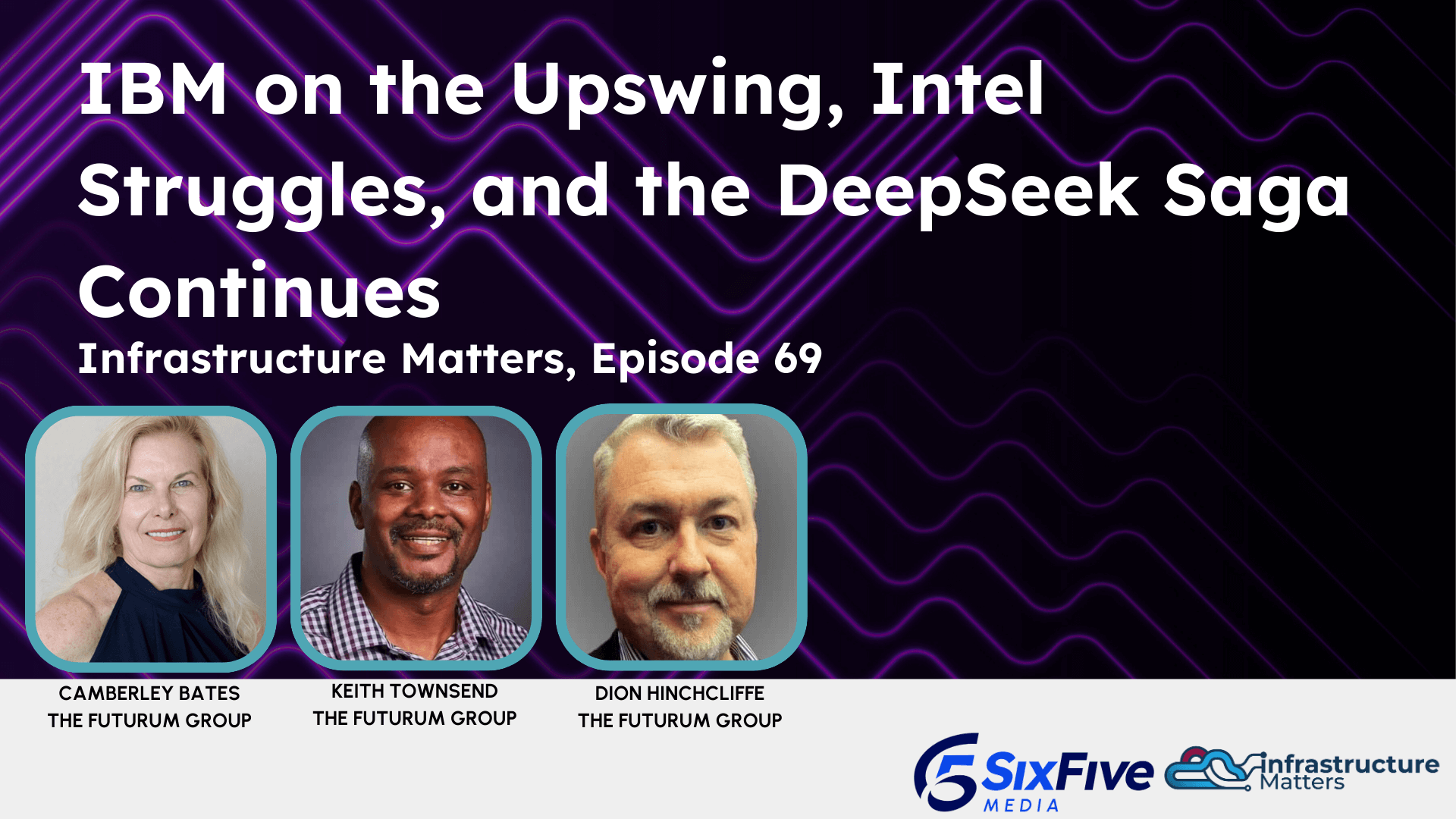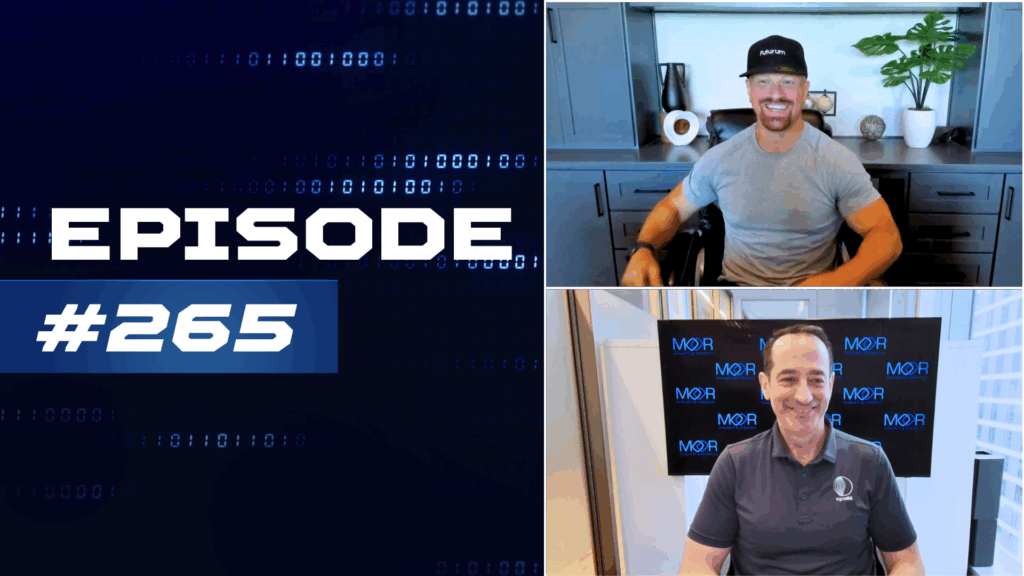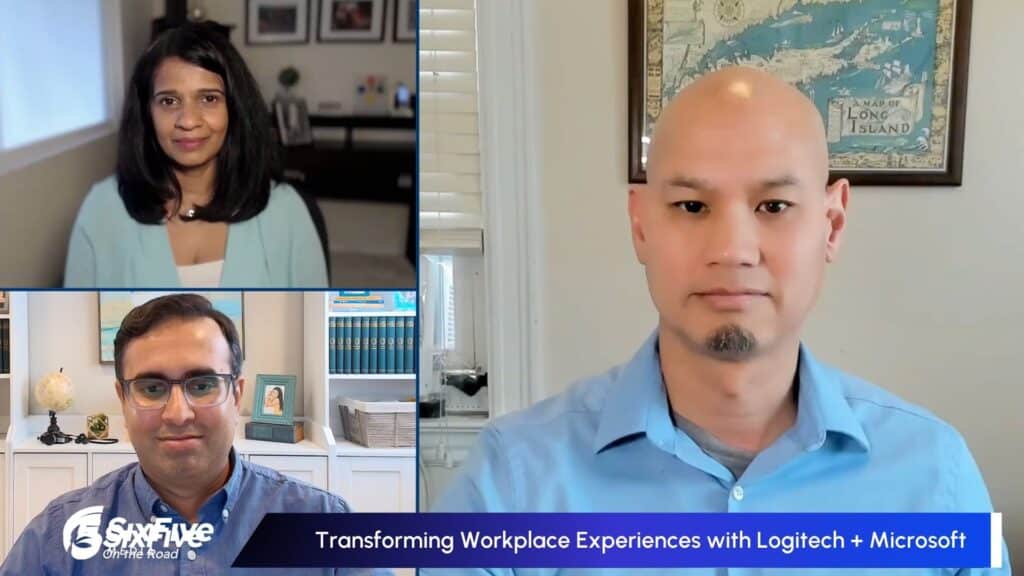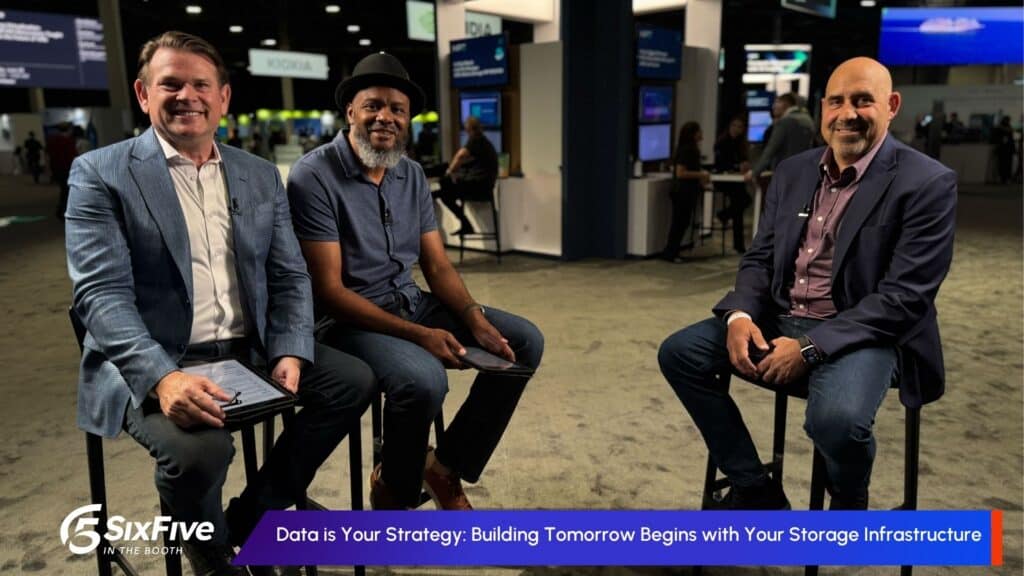On this episode of the Six Five Webcast – Infrastructure Matters, hosts Camberley Bates, Keith Townsend, and Dion Hinchcliffe discuss the latest developments and challenges in the tech industry. The discussion delves into IBM’s recent successes, Intel’s ongoing struggles, and the unfolding saga of a remarkable technology known as DeepSeek.
Their discussion covers:
- The factors contributing to IBM’s current upswing and what it indicates about their strategic direction.
- Intel’s challenges amidst a competitive semiconductor market and potential strategies for recovery.
- An in-depth look into the DeepSeek technology, its implications, and why it’s a topic of continuous interest.
Watch the video below, and be sure to subscribe to our YouTube channel, so you never miss an episode.
Or listen to the audio here:
Disclaimer: Six Five Webcast – Infrastructure Matters is for information and entertainment purposes only. Over the course of this webcast, we may talk about companies that are publicly traded and we may even reference that fact and their equity share price, but please do not take anything that we say as a recommendation about what you should do with your investment dollars. We are not investment advisors, and we ask that you do not treat us as such.
Transcript:
Dion Hinchcliffe: Hello everyone and welcome back to Infrastructure Matters episode 69. Wow, it’s been a pretty interesting year so far. It’s been lots of revelations on AI, and new administration, lots of executive orders. But let’s get right into the news. We were talking about IBM had a very interesting … Or sorry, IBM or IBB, what is it?
Camberley Bates: IBM. That was my mistype.
Dion Hinchcliffe: That’s what I thought. I’ve absolutely been loving what they’ve been doing with AI on … In terms of enterprise-class models with their Granite model, the new 3.0 version, so I’ve watched that closely but I haven’t been tracking their earnings. So Camberley can you catch us up?
Camberley Bates: Yeah. They did very, very well. I mean, it’s not like 20% that we saw with another firm which was Commvault but it’s IBM and some very big revenue growth of 3%, 12.7 billion of free cash flow. Arvind talked a lot about where they were in ’21, where they are now of setting the plan that they had for mid … Single digit growth, and they delivered that, which is a 6% CAGR over that period. What really, really grew was their software. That business has grown significantly. Driven, not just by Red Hat. Because over the last few quarters we’ve been talking a lot about the Red Hat stuff but also about their AI initiatives with Watson, et cetera, those have all done very well as has transaction processing. People know I keep talking about the mainframe, it’s not dead. And boy, it’s not dead. This year they’ll be releasing the next generation of the Z.
A couple of things he said. This is the 11th quarter of the Z16. I’m quoting exactly, “Three years in this product has outpaced prior cycles and programmed to date with over 30% of the client of” … “Increased over 30% as clients capacities continue to grow.” I think the number that they quoted was 60% … Or 70% of their clients have increased their capacity. That’s also driven in some of the things that are going on there is the AI work that’s going on with transformation of the cobalt technology. So expect this next year, as they release the next release, is going to be astounding well. The other thing that I loved that they said, they have had huge momentum with Red Hat. Fourth quarter was 17% growth. So they continue to do double bookings, double-digit bookings. But one of the things that they alluded to is that some of this is getting driven by VMware. They didn’t say VMware but they said they continue to see the increase of the OpenShift virtualization engagements. And they didn’t quote a number there. We’ve all been talking about how much is this happening, are they really getting off of it? Is this really changing? Of course, That-
Dion Hinchcliffe: And their offering is quite popular. At their recent analyst day, I think some of us attended, they were real clear that they had a migration offering to make that the Easyapp. That some CIOs wanted to take them up on that.
Camberley Bates: That’s done really well so expect … Next year they are expecting a banner year. I mean, they’ve got a huge book of business on the AI side of the house. Both on the software and the consulting business that’s going on. So I’ll stop there. But that’s really, really good news.
Dion Hinchcliffe: I just finished a major piece of research looking at all the different agentic AI frameworks and solutions include ,,, A Watsonx was included in that. They scored I think number two, number three across the whole field. And this is a stark departure from their very flaccid results with Watson way back in the day. I mean, looking at all these results and people wanting to put their … Run their cloud on IBM and use their AI, is IBM back? They seemed like they were heading towards the long good night.
Camberley Bates: Go ahead.
Keith Townsend: IBM has always had a seat at the table, right? They bought PwC’s legacy consulting business. They’ve always been strategic. When you have a RFP for a ERP solution, IBM is going to be at the top of, if not providing the actual solution, implementing and process change. I’ve long said that the value of AI is in the ability of solution integrators to be able to help with the change. And IBM is just … They have it within their fabric to understand both the technology and the process change needed. So it’s not a surprise. I think a lot of us who’ve watched the industry for a long time have said that IBM is probably one of the best position to capitalize off of AI. And we’re starting to see them get out of their own way, quite frankly, and telling their cloud story and their end-end value prop.
Camberley Bates: One of the line items that Arvind’s talked about … I think it was him that responded to the Q&A from the investors. They talked about the smaller models. We were going to talk slightly about DeepSeek so we may want to go to that now. But talked about the value of the smaller models. And that they have seen a 60% cost or efficiency number in using the smaller models for inference engine … Inferencing. All the noise on the DeepSeek thing is what the cost about it was. I mean, we talked about the speed of it, but what the cost around it was that we talked last weekend. And this is, again, that innovation that we’re going to see that’s going to drive down the cost of delivering of what we’re doing with AI. And I think IBM has got some … Definitely is in the game.
Dion Hinchcliffe: Their value prop is they say the Granite 3.0 has got very close to the performance of the top models but at 1/10 the cost, right? IT budgets right now are ballooning because of the expectations around what it takes to run AI. And so IBM is like, “Hey, you don’t have to take that head if you work with us” which I think is a really smart move. Although I think trying to get to the top spot based on pricing is not necessarily always the smartest move.
Keith Townsend: And again, I want to reiterate that inferencing is not going to take the GPU and power requirements of training. We just did AI Field Day 6, I should have put that in the rundown … As part of AI Field Day 6 we talked to VMware, MemVerge, and a small company Kamiwaza that helps us internally with some of our Signal65 testing. The consistent theme is coming out that customers are still asking the question, how many GPUs do I need? We’ll get into DeepSeek. But I think IBM, granted, is doubling down on this idea that you know what? On training, yes, you’re going to need the multiple megawatt or the 1-megawatt rack at some point. But for inferencing, small models, more traditional air-cooled systems are what is probably going to win the day in the enterprise.
Dion Hinchcliffe: Let’s do Seagate real quick and then let’s dive into what’s happening with DeepSeek.
Camberley Bates: There was two companies that announced earnings in the last week on hard drives. And I bring that up also because I talked about mainframe which is not dead yet. HDDs are not dead yet either. And that was Seagate and Western Digital. Seagate’s stock jumped … Had a big jump from it and is like “All right, this is” … “Who cares about HDDs?” WDC was like “Not that great.” They have two parts of their business, one is the flash side which is not doing well, and the other is the HDD side. So why are HDDs still in play? If we’re talking the enterprise, they’re migrating to solid state. A big portion of that is what’s going on with the cloud. So much of the data is on HDDs. They are not moving off those devices. And they are shipping them. As soon as they start talking about opening more data centers, well that’s going to … Just rolling them into big huge racks of HDDs. I’ve got a friend of mine that’s a sales rep for them and we talk about “You’re just going to roll these big huge racks of drives in there and they’re going to deploy them themselves, et cetera.” So that’s what’s happening there. It’s not dead yet.
Dion Hinchcliffe: I think they got a little bit of life left in them giving their huge patent portfolio in storage and things like that.
Camberley Bates: But we’re also seeing the enterprise is still buying hybrid systems. I just had a call with NetApp and they were talking about their hybrid systems, the solid state and hard drive for secondary storage is still very alive and well. I think it’s well over 50% of their business still in terms of that … The on-tap arrays that they’re shipping.
Dion Hinchcliffe: I mean, I was just talking to some CEOs in the Midwest …is in the Midwest, and it was surprising how very much in the 2000s they still are, right?
Keith Townsend: If we dig into it, computer’s becoming dense. We’re seeing it in GPUs, et cetera. One of the things that we’re battling from an architect perspective, how much do I sacrifice in space. Obviously, SSDs are denser than HDDs. But from a practical perspective, if the rest of my computer is shrinking, if … What do I care about performance, energy costs, et cetera? There is a argument that if I’m … If I have excess rack space and HDD costs are lower per terabyte than SSD, okay … This is something that I think we’ll have to ping our Signal65 peers on. Where’s the real value point of SSDs versus HDDs and help customers make better purchasing decisions? I don’t think this is a obvious price per terabyte question, it is a question of how much is it costing me and what’s my operational overhead to run one stack over the other?
Camberley Bates: Well, you can get Mitch Lewis on here from Signal65 because he’s done some of that analysis. It’s an interesting analysis in terms of what you can pull. What you can do in the data center.
Dion Hinchcliffe: We’re talking about data. The big saga from last week is still ongoing and that is the arrival of a highly capable frontier model that apparently doesn’t take a lot of compute to use. The whole question now still centers around how did DeepSeek create its model, and that’s the huge debate. Some data came to light that 20% of all of NVIDIA’s GPUs go to Singapore which is probably highly unlikely. And that’s probably the vector, the forward shipping location for GPUs into China. That’s been top of mind for a lot of folks because it’s really greatly impacted the stock market, VC investment, a bunch of things in terms of where AI is really going to go. And it’s becoming clear as we really analyze, DeepSeek didn’t use CUDA. That was, I think one of the most interesting revelations. They went bare metal for their AI stack so they could do all kinds of super optimizations to make inference really, really cheap. I’m tracking the list of the optimizations that DeepSeek has on AI and it keeps saying longer and longer. And a lot of it’s because they said, “Well, we’re not going to use that. We’re going to do really extreme optimizations in our use of these GPUs to squeeze out every last bit of capability.” What are you guys seeing in terms of how DeepSeek is recalibrating the AI landscape?
Keith Townsend: One of the things that I’m paying attention to is, again, the inferencing from a technical level. A really interesting tweet or X post, whatever we call tweets anymore on Twitter, is one of the engineers, at large engineers, posted the configuration for running DeepSeek on dual-processor AMD EPYC CPUs. So DeepSeek is memory bound. So we talk about the importance of GPU versus CPU architecture. And it seems that the biggest factor is … In its recursive way that it does reasoning is the amount of RAM. So this 700 billion parameter model acts like a 45 billion parameter model so you can run it on systems with less oomph. This issue about this dual CPUs air cooled system with no GPUs, 768 gig of ram looks very much like a typical virtualization server, I have them in my lab, to run DeepSeek at about 10 tokens per seconds which is not pretty usable from a production perspective but from a lab perspective very achievable. I know that if you ran this on one of the Digit’s developer platforms that Nvidia announced, and we covered a few weeks ago, you can get a few thousand tokens per second with DeepSeek. So that is a GPT-o1 level-
Dion Hinchcliffe: Let’s say you run top of the line AI-
Keith Townsend: Right.
Dion Hinchcliffe: On a single machine that’s right in front of you, right?
Keith Townsend: That is on your desktop. So essentially a desktop. That is game changing which goes to the argument around what IBM is saying around Granite. For a trusted model that does the job for your … A use case, you don’t need big GPUs to do this.
Camberley Bates: I said this last week, scarcity is a mother of invention. When things are scarce we now all … We start optimizing which we’re talking about. You’re going to look at all the areas that you need to optimize in order to deliver on. We’re going to see that in many, many places especially as we saw the dollar signs on this. My concern around that is what does that mean to these forecasts that we’re having about how much it’s going to drive? Then I go back to saying, I can remember when we would start shipping PCs or whatever with this massive capacity. How you would ever use all that capacity? Well, we always do. So one, scarcity is the mother of invention and we will use whatever capacity we have. Darn it, I used all my closets in my very, very large house.
Dion Hinchcliffe: I think that’s a great prove point. I mean, the real issue is going to be is how long is DeepSeek going to be with us just because … Italy has now blocked DeepSeek, the Department of Defense has blocked DeepSeek. It may be hitting the way of TikTok just because it-
Keith Townsend: Yeah, I think-
Dion Hinchcliffe: Go ahead.
Keith Townsend: I think the big difference is that you can run it locally. Unlike TikTok, unlike some of these other Chinese platforms, it’s open source. I can just download it, and run it, and … On my desktop literally. So it’s going to be very-
Camberley Bates: You sure it doesn’t have a call home button you’d-
Keith Townsend: Well, that’s the worry.
Camberley Bates: You sure it doesn’t have a call home button you don’t know about?
Keith Townsend: Well, we have some pretty good computer scientists here we’ll figure that out. I don’t think users are really worried. There’s what 100 million TikTok users in the US? I don’t think we really worry much about our data being to the CCT. We probably should but we don’t.
Dion Hinchcliffe: The big story for 2025 and AI for sure is, is this the long-expected commoditization of generative AI. And this will force a real rethink. We talked about Project Stargate, $500 billion to train these models. And so if they’ve got the shortcut to creating these very lean … Do lean training, lean inference it’s going to be … It’s going to change a lot of things. It could put China in the leader position with AI by the end of the year. That’s the real concern, I guess, in a lot of quarters. All right, let’s move on to other news. So Intel. Speaking of chip companies that have had some challenges recently, they had some delays and some product cancellations announced yesterday. So Falcon Shores which is Intel’s much touted XPU, which is a combination of CPU and GPU in a single unified package, they decided not to run with it as a product, they’re going to only use it as a test chip inside the company. It raises a lot of questions about Intel’s capability in terms of really competing in the AI era. I don’t know, Keith, do you have any reaction to that news in particular?
Keith Townsend: I think the architecture has promise. The big GPU farms that, again, we see in Meta, we see in, and we see in … Across all of the big producers or models, we’re not going to replicate that in the enterprise so we need something in between. A small service provider actually in Australia noted that after DeepSeek they saw a doubling in request for AMD accelerators based on the demand for DeepSeek. I think we are going to see these markets shift on how we use accelerators in a data center, whether these are on-chip … I think CPU on-chip accelerators route stuff like running DeepSeek on two EPYC or Intel Xeon CPUs is interesting. It’s not what’s going to happen, we need some combination of accelerator and CPU. And I think Intel is deciding that Falcon Shores isn’t it? I hadn’t even heard of it until it was killed. But I do believe Intel is going to return back to its days of that … The specialty ASIC, the programmable ASIC combination of that and CPU. It was the right model. Probably a little early but I think we’ll see the return of it in some way.
Dion Hinchcliffe: I’ve been bullish for … On FPGAs for a long time just because they have such potential to create a hardware performance for software-based applications. The problem is it’s very hard to develop for them. Just like multi-threading was so hard to develop for, still is hard to develop for, for a lot of folks that take advantage of these super high-core CPUs which is the other news, Intel has delayed Clearwater Forest, that’s their Xeons, on the 1.8 nanometer process which is just amazing to me. I don’t know how many more nanometers there were to shave off the process. That’s astounding. I don’t think it was unexpected. The current Xeons have 288 cores, or the versions that’ll be released this year. So that was bringing it a little bit close in if they were going to ship this the first quarter in 2026. Now it’s pushed off to later in 2026. It might be later than that. That is an amazing advance that they’re … That Intel’s bringing on the ultra-advanced process ahead of much of its competition. Camberley, you had some news around edge computing infrastructure. Why don’t you tell us a little about that?
Camberley Bates: That’s actually Keith, he’s running-
Dion Hinchcliffe: Go ahead, Keith.
Camberley Bates: With the edge stuff.
Keith Townsend: Yeah, so-
Camberley Bates: He’s going to be edge.
Keith Townsend: And we don’t miss Elon Musk on this podcast. But Elon announced or mentioned that, unfortunately, if you bought a Tesla pre-2022, 2023 and you were expecting full self-driving, FSD, you’ll need to upgrade. The computer system originally was hardware 2.0. In the 2016 model, hardware 2.5. And 3.0, been a lot of controversy around this promise of full self-driving, being able to be just a software download. Well, evidently it’s not. It requires a hardware upgrade to hardware 4.0.
Camberley Bates: So Infrastructure Matters.
Keith Townsend: So infrastructure does matter. So it is a question about an example of life cycle. While I’m bullish on the idea of running DeepSeek on CPUs, that’s probably a little bit aggressive to what’s going to actually happen at the edge. So as we push AI further out to the edge we really need to consider what is our life cycle strategy around managing those physical components. Because as we depend on our business processes being enhanced by AI and more compute at the edge, software will eventually outstrip the hardware.
Camberley Bates: Do you know why Tesla is saying you have to upgrade or to, I guess, swap out the hardware that’s in there? And what that-
Keith Townsend: Yeah. Just they underestimated the hardware needs of FSD. I think this is yet another lesson. This is something that as advisors we always talk about. Don’t buy hardware or software based on the potential what it can do but the value that it adds today because that potential may never come throughout the depreciation life cycle of the equipment. And this is just a classic example of buying on the promise versus buying on the actual capability.
Camberley Bates: I’m assuming what this was is the processing power was not strong enough.
Keith Townsend: It wasn’t strong enough for the software.
Camberley Bates: The amount of data that they’re going to need to process whether it’s memory or processing power or whatever that’s going on there. Okay.
Keith Townsend: Whatever CPU that’s needed to process the real-time data coming from off the cameras it just wasn’t enough based on their continued development of FSD software.
Camberley Bates: We’ve talked for many years. The market has talked about the software-defined data center, right, the software-defined world. Everything’s software, everything’s software. It’s like yes, but you still need to have the oomph behind it to drive it, literally. Literally In this situation.
Dion Hinchcliffe: And this is why I’ve been fairly bullish on FPGA because what if you could recompose the hardware? That’s the thing. You come up with superior designs, you can just reprogram everything down at the … Right on the chip to run more efficiently without having to ship new chips. Yeah, if you’re doing really software defined that would be the ultimate potential. But we’re not there yet. I’m glad to see you can actually run … Recompile C code now into FPGAs pretty easily. It’s interesting, yeah.
Keith Townsend: And DeepSeek is that example, right? They bypassed the abstraction layers of CUDA. CUDA is very convenient for developing platforms on top of NVIDIA chips. These researchers say, “You know what? We’re going to go the old assembly-level language map route and we’re going to program directly to the hardware to get out every inch of efficiency.” 100% efficiency versus 60 to 70%. 70% would be outstanding for GPU performance. So they’re claiming 100% efficiency. So from the networking, storage, and compute capabilities you can only do that by going as low level as possible. And to your point, Dion, FPGAs allow you at least the option to do that.
Camberley Bates: So this gets into, because I think of the life cycle of what you’re talking about with Tesla. I mean, are we getting into a point now we’re looking at a three-year life cycle on this? I mean, that’s costly. Then I have to look at an ROI very, very differently. Typically on any server deployment I’m looking at … Five years on a server or is it-
Keith Townsend: Typically five years. The five years before the server becomes free? Then we sweat those assets for as long as we can. If it’s running and we have support on it why get … Why accumulate additional depreciation costs? The bigger point is life cycle management. We’ve set up our environments in which we can switch out this hardware on a rolling five-year schedule. If now I have to go down to three years or less, that’s a big challenge for the enterprise.
Camberley Bates: Right. And I start to think about okay, so what use cases are we talking about that’s hitting? Okay, let’s start with retail. I’ve worked retail, I understand the pain of doing a training … Doing an upgrade into all those stores. You’re talking thousands of stores or something. I’m Home Depot I’m implementing-
Dion Hinchcliffe: Let’s say the AI-powered checkout list at checkout which is you can just grab the items and go out but that requires spatial recognition, item recognition, and connection to the ERP system, the … All those types of things in real-time and that will consume a lot of power. That’s the use case we’ll see. That’s a step function up to a whole new level of compute for an average retail organization.
Keith Townsend: Yeah, it reminds me, I need to reach back out to the chief architect of Chick-fil-A. A few years ago they rolled out Intel NUCs to run Kubernetes at every store so every store was a software platform. The Intel NUC is not even offered anymore so how are they managing that platform lifecycle out at the edge? It raises a really interesting question.
Camberley Bates: More to do.
Dion Hinchcliffe: Well, that brings us to time for this episode. Thanks for sticking with us this long. Next episode’s episode 70. We’ll see you next week.
Author Information
Camberley brings over 25 years of executive experience leading sales and marketing teams at Fortune 500 firms. Before joining The Futurum Group, she led the Evaluator Group, an information technology analyst firm as Managing Director.
Her career has spanned all elements of sales and marketing including a 360-degree view of addressing challenges and delivering solutions was achieved from crossing the boundary of sales and channel engagement with large enterprise vendors and her own 100-person IT services firm.
Camberley has provided Global 250 startups with go-to-market strategies, creating a new market category “MAID” as Vice President of Marketing at COPAN and led a worldwide marketing team including channels as a VP at VERITAS. At GE Access, a $2B distribution company, she served as VP of a new division and succeeded in growing the company from $14 to $500 million and built a successful 100-person IT services firm. Camberley began her career at IBM in sales and management.
She holds a Bachelor of Science in International Business from California State University – Long Beach and executive certificates from Wellesley and Wharton School of Business.
Keith Townsend is a technology management consultant with more than 20 years of related experience in designing, implementing, and managing data center technologies. His areas of expertise include virtualization, networking, and storage solutions for Fortune 500 organizations. He holds a BA in computing and an MS in information technology from DePaul University.
Dion Hinchcliffe is a distinguished thought leader, IT expert, and enterprise architect, celebrated for his strategic advisory with Fortune 500 and Global 2000 companies. With over 25 years of experience, Dion works with the leadership teams of top enterprises, as well as leading tech companies, in bridging the gap between business and technology, focusing on enterprise AI, IT management, cloud computing, and digital business. He is a sought-after keynote speaker, industry analyst, and author, known for his insightful and in-depth contributions to digital strategy, IT topics, and digital transformation. Dion’s influence is particularly notable in the CIO community, where he engages actively with CIO roundtables and has been ranked numerous times as one of the top global influencers of Chief Information Officers. He also serves as an executive fellow at the SDA Bocconi Center for Digital Strategies.











